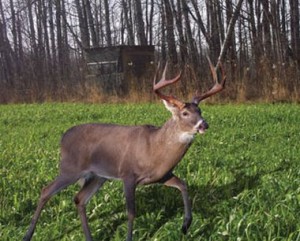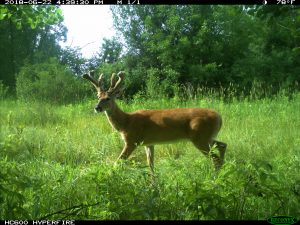Mixed clover food plots for deer
Mixed Clover food plots for deer are a no brainer

Clover food plots for deer are economical, and a must for the serious deer farmer. Clover food plots for deer are easy to establish, require little maintenance and can last for years with very little upkeep. My first food plot was an old trail that I worked and transformed into a clover food plot, and it has been used extensively by deer, turkey and ruffed grouse every year. It’s starts right outside the kitchen window of the cabin and brings lots of critters into the yard each year. Lets look into the planning, planting, and maintenance of clover food plots for deer.
Planning mixed clover food plots for deer
Mixed Clover food plots for deer, just like any other monoculture you plan on growing, require certain conditions for optimal growth. It’s important to set the stage for success as your plot will do much better at outcompeting grasses and weeds if you plant it in the proper environment. Clover food plots for deer have a rather shallow root system, so they require adequate soil moisture. This makes them an ideal choice for planting walking trails in the woods. The shade provided by the canopy of the hardwoods keeps the ground moisture high, enabling the shallow roots of your clover food plots for deer adequate moisture to grow and thrive. This canopy of shade is not tolerated by annual plantings such as brassica, soybeans or corn, and is another reason we find clover on trails in the woods. 3 to 4 hours of sun per day is enough to grow clover food plots for deer in the woods.
Clover is a perennial, which means it comes back every year. It will grow back from the roots as well as any seed it may drop on the ground. One trait of most perennial plants is the desire for a proper ph. Annuals such as corn and beans will grow in soils with a lower ph of 5.3 to 5.9, but your clover will not perform well in a soil ph of under 6.0. A $12 soil test from your local ag office will let you know how much lime you will need to add to adjust the ph of your selected area. Do not skip this step, as most wooded areas will run a ph in the low 5’s, too low for your clover to be as productive and attractive as you need it to be to attract game. Clover food plots for deer will do much better with a simple application of pelletized lime every couple years.
Planting mixed clover food plots for deer
Clover food plots for deer are best planted in the fall of the year. Take the spring and summer months to get a complete vegetative kill with 2 applications of round up, and work the seed bed well to incorporate all the top laying vegetation into the ground. This will get your seed the necessary soil contact for successful germination and root growth. In Minnesota we will plant clover in the months of September and October, and even November works if the snow is not yet on the ground. We are not aiming for a crop the first fall, we just want to get our clover food plots for deer a good start on their root structure so the can go crazy the next spring. Take this advice and plant your clover food plots for deer in the fall so you are not fighting all the weeds in your seed bad waiting to germinate. Let those seeds pop open in May and August, kill them with round up, and then plant your plots in a stress free weed free environment.
Maintaining mixed clover food plots for deer
Clover food plots for deer can last forever with proper care. We will mow it twice a year in June and August. Mowing the plot does 2 things. Mowing keeps your clover food plots for deer from going to seed. If we let the plots form seed heads, they will devote all of their energy to growing seed, and the plant becomes less tasty to the deer herd. Animals love green growing plants, and when the seed head forms, the plant stops growing. Mowing also keep broadleaf weeds from going to seed. By cutting off the broadleaf seed head, we prevent those seeds from maturing and polluting our clover food plots for deer.
Grasses are your number 1 enemy in plot longevity. They will creep in and can not be controlled with mowing. When the grasses invade our clover food plots for deer, a selective herbicide such as Arrow must be used to kill the grasses. Mow for broadleaf control, and spray the grasses for an eternal clover food plot for deer.
Every couple years we will also do a fall over seed, and fertilization low in nitrogen to keep our clover food plots for deer healthy. It’s really fairly easy to establish clover food plots for deer. Follow these simple steps, and your clover food plots for deer will help keep those whitetails on your land year round.


